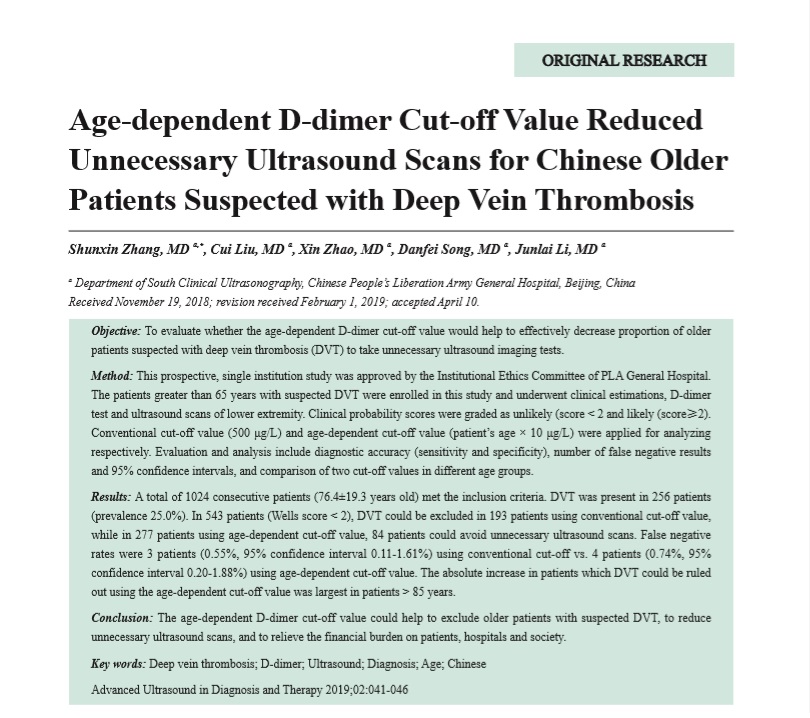

ADVANCED ULTRASOUND IN DIAGNOSIS AND THERAPY >
Age-dependent D-dimer Cut-off Value Reduced Unnecessary Ultrasound Scans for Chinese Older Patients Suspected with Deep Vein Thrombosis
Received date: 2018-11-19
Online published: 2019-06-28
Objective: To evaluate whether the age-dependent D-dimer cut-off value would help to effectively decrease proportion of older patients suspected with deep vein thrombosis (DVT) to take unnecessary ultrasound imaging tests.
Method: This prospective, single institution study was approved by the Institutional Ethics Committee of PLA General Hospital. The patients greater than 65 years with suspected DVT were enrolled in this study and underwent clinical estimations, D-dimer test and ultrasound scans of lower extremity. Clinical probability scores were graded as unlikely (score < 2 and likely (score≥2). Conventional cut-off value (500 μg/L) and age-dependent cut-off value (patient’s age × 10 μg/L) were applied for analyzing respectively. Evaluation and analysis include diagnostic accuracy (sensitivity and specificity), number of false negative results and 95% confidence intervals, and comparison of two cut-off values in different age groups.
Results: A total of 1024 consecutive patients (76.4±19.3 years old) met the inclusion criteria. DVT was present in 256 patients (prevalence 25.0%). In 543 patients (Wells score < 2), DVT could be excluded in 193 patients using conventional cut-off value, while in 277 patients using age-dependent cut-off value, 84 patients could avoid unnecessary ultrasound scans. False negative rates were 3 patients (0.55%, 95% confidence interval 0.11-1.61%) using conventional cut-off vs. 4 patients (0.74%, 95% confidence interval 0.20-1.88%) using age-dependent cut-off value. The absolute increase in patients which DVT could be ruled out using the age-dependent cut-off value was largest in patients > 85 years.
Conclusion: The age-dependent D-dimer cut-off value could help to exclude older patients with suspected DVT, to reduce unnecessary ultrasound scans, and to relieve the financial burden on patients, hospitals and society.

Key words: Deep vein thrombosis; D-dimer; Ultrasound; UDiagnosis; Age; Chinese Advanced
Zhang, MD Shunxin , Liu, MD Cui , Zhao, MD Xin , Song, MD Danfei , Li, MD Junlai . Age-dependent D-dimer Cut-off Value Reduced Unnecessary Ultrasound Scans for Chinese Older Patients Suspected with Deep Vein Thrombosis[J]. ADVANCED ULTRASOUND IN DIAGNOSIS AND THERAPY, 2019 , 3(2) : 41 -46 . DOI: 10.37015/AUDT.2019.190808
| [1] | White RH. The epidemiology of venous thromboembolism. Circulation 2003; 107:I4-8. |
| [2] | McPhee SJ, Papadakis MA. Current Medical Diagnosis and Treatment, Forty-Sixth Edition. New York: McGraw-Hill Companies Inc; 2007. |
| [3] | Harper PL, Theakston E, Ahmed J, Ockelford P. D-dimer concentration increases with age reducing the clinical value of the D-dimer assay in the elderly. Intern Med J 2007; 37:607-13. |
| [4] | Righini M, Goehring C, Bounameaux H, Perrier A. Effects of age on the performance of common diagnostic tests for pulmonary embolism. Am J Med 2000; 109(5):357-61. |
| [5] | China National Human Development Report 2016: social Innovation for Inclusive Human Development Report 2016: social Innovation for Inclusive Human Development. China Translation & Publishing House; 2016. p. 84. |
| [6] | Douma RA, le Gal G, S?hne M, Righini M, Kamphuisen PW, Perrier A, et al. Potential of an age adjusted D-dimer cut-off value to improve the exclusion of pulmonary embolism in older patients: a retrospective analysis of three large cohorts. BMJ 2010; 340:c1475. |
| [7] | Wells PS, Anderson DR, Bormanis J, Guy F, Mitchell M, Gray L, et al. Value of assessment of pretest probability of deep-vein thrombosis in clinical management. Lancet 1997; 350:1795-8. |
| [8] | Wells PS, Anderson DR, Rodger M, Forgie M, Kearon C, Dreyer J, et al. Evaluation of D-dimer in the diagnosis of suspected deep-vein thrombosis. N Engl J Med 2003; 349:1227-35. |
| [9] | Pieper CF, Rao KM, Currie MS, Harris TB, Cohen HJ. Age, functional status, and racial differences in plasma D-dimer levels in community-dwelling elderly persons. J Gerontol A Biol Sci Med Sci 2000; 55:M649-57. |
| [10] | Chopra N, Doddamreddy P, Grewal H, Kumar PC. An elevated D-dimer value: a burden on our patients and hospitals. Int J Gen Med 2012; 5:87-92. |
| [11] | Fan J, Li X, Cheng Y, Yao C, Zhong N. Investigators Group.Measurement of D-dimer as aid in risk evaluation of VTE in elderly patients hospitalized for acute illness: a prospective, multicenter study in China. Clin Invest Med 2011; 34:E96-104. |
| [12] | Gu HX, Sun XF, Zhang B, Lv Y, Huang DW, Chen XM. Plasma D-dimer increased with aging in healthy adult. Shandong Medicin 2010; 50:17-19. |
| [13] | Douma RA, Tan M, Schutgens RE, Bates SM, Perrier A, Legnani C, et al. Using an age-dependent D-dimer cut-off value increases the number of older patients in whom deep vein thrombosis can be safely excluded. Haematologica 2012; 97:1507-13. |
| [14] | Haas FJ, Schutgens RE, Biesma DH. An age-adapted approach for the use of D-dimers in the exclusion of deep venous thrombosis. Am J Hematol 2009; 84:488-91. |
| [15] | Johnson SA, Stevens SM, Woller SC, Lake E, Donadini M, Cheng J, et al. Risk of deep vein thrombosis following a single negative whole-leg compression ultrasound: a systematic review and meta-analysis. JAMA 2010; 303:438-45. |
/
| 〈 |
|
〉 |